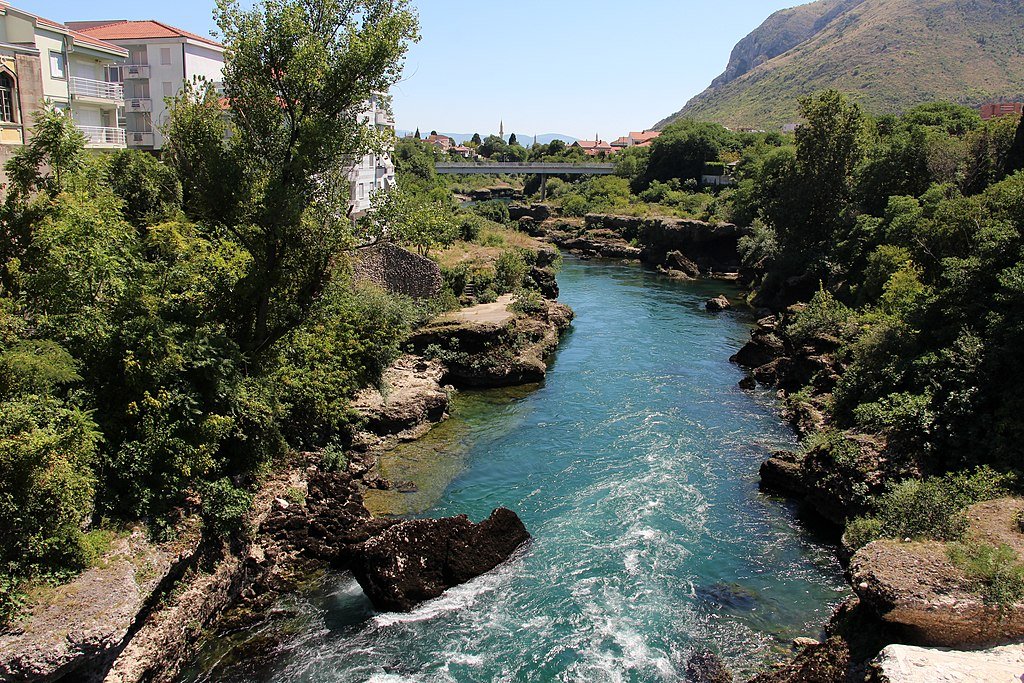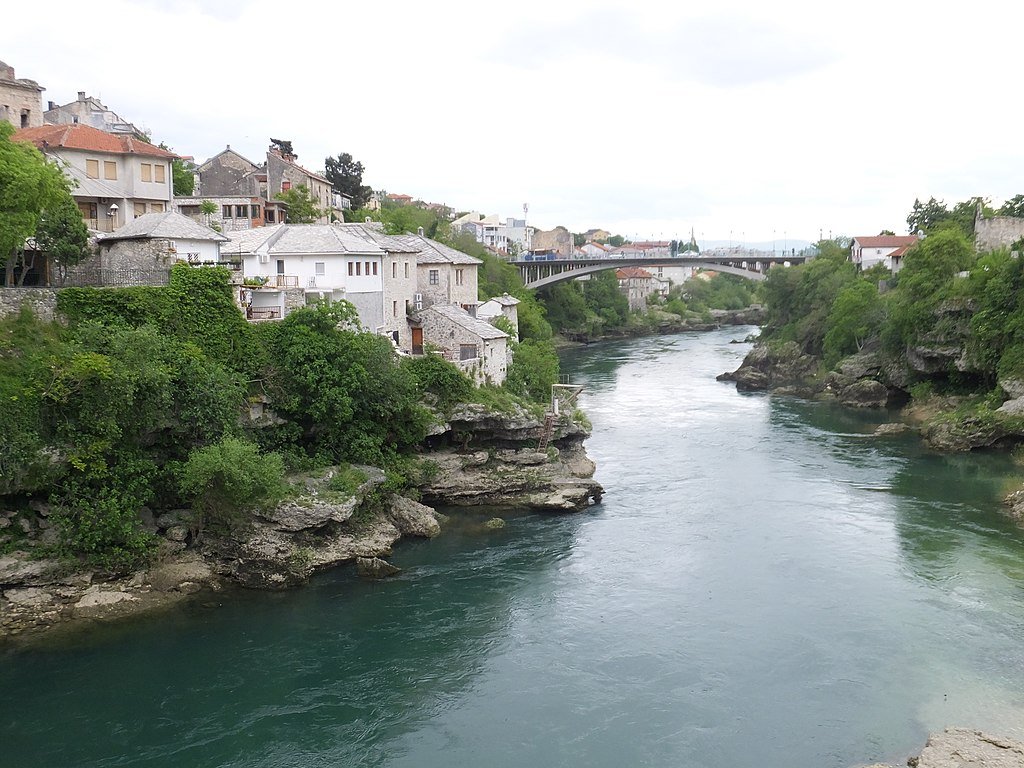Mostar // Bridge by Boring Bridge
The view from Musala Most // © WikiMedia Commons
It is almost redundant to say, but Mostar’s Stari Most is a fabulous bridge. Bosnia and Herzegovina is a country full of gorgeous bridges, and the pearler that stands over the Neretva connecting the two sides of Mostar’s old town is arguably the best of them all. I’ve not been shy of documenting my love for it, and I’m almost certain it will remain my favourite non-human thing on the planet until the day I die. You can keep your Eiffel Towers, your Grand Canyons, your Taj Mahals; feed me the Stari Most.
All true, all worth repeating over and over again. The conversation about bridges in Mostar begins and ends with the Stari Most, but there are other bridges here, you know? Quite a few actually, as the Neretva strides through a city that still needs to get from east to west and west to east, despite what the world seems to think. The Kriva Ćuprija comes a close second on the photogenic front and is an absolute delight, but it is clearly a case of style over substance. Away from the old town, several bridges do the donkey’s work, allowing vehicles to come and go from side to side, quietly going about their business without searching for acclaim or celebration.
Other bridges of Mostar, today is your lucky day. Well, for three of you, anyway. Let’s shine a light on Mostar’s three most important bridges, in terms of boring old modern practicalities.
We’ll start with the Musala Most, being the second oldest in the city and all that. Like many things in this part of the world, it has seen its fair share of name changes, but the colloquial moniker it is filed under here has been ubiquitous throughout. Emperors, kings and Titos come and go, but neighbourhoods are eternal. This isn’t true, but it does make for nice copy, so I’m sticking with it.
Musala Most // © John Bills
Work on the Musala Most began in 1873, as the Ottoman Empire looked to ease the pressure and traffic on the Stari Most. This was all good and well, but the Ottoman Empire was on its arse, for want of a different phrase. That ‘Sick Man of Europe’ nickname wasn’t ironic, you know. Work on the bridge was almost immediately stopped due to a combination of cost and rebellion, as the good people of Herzegovina tried tirelessly (and violently) to remove the suffocating hand of Constantinople. The Musala Most was completed in 1882, but there were different overlords.
That’s right, the Austro-Hungarians were in town. The bridge’s first name was Franz Josef Bridge because of course it was, although shabby workmanship meant it was already being reconstructed by 1888. Still, it did its job, and Mostar was able to accommodate a world that was becoming increasingly mechanic. You aren’t getting cars over the Stari Most, after all.
In 1936, with the Austro-Hungarians long gone, the bridge was renamed King Peter’s Bridge. Less than a decade later, it was Tito’s Bridge, a name that stayed until Bosnia and Herzegovina declared independence in 1992, although the changing names shouldn’t get too much attention. After all, this is the Musala Most. It has never really been anything else.
First Stari, second Musala, third time Lucky. Okay, it isn’t actually called the Lucky Bridge, but for some reason, I decided to call it that back in 2010, and I’m sticking with it. On the other side of the Stari Most from Musala, the Lučki Most has been called different things too, although Lučki wins out. Again, neighbourhoods are eternal.
Lučki Most // © WikiMedia Commons
Constructed in 1913, it was another project financed by Mostar benefactor Mujaga Komadina, and his name was slapped on the bridge when it was finished a year later. The bridge was built to, funnily enough, ease the pressure on the Musala Most, as Mostar was continuing to develop at the sort of pace the early 20th century demanded, with tobacco factories, carpentry and the rest needing more access points. What’s surprising about its first official name? Not a whole lot, other than the fact that it was rare for local people to be celebrated in such a way. Mujaga Komadina was no ordinary local, after all.
There are historical curiosities here. For one, a toll was only paid when travelling from right to left, and travellers going left to right crossed for free. Lučki Most was the first bridge made of reinforced concrete in Bosnia and Herzegovina and had one of the biggest spans of any bridge in Europe at the time. It has obviously lost that latter title in the 21st century, but there is plenty to love about Lučki Most in the modern world. After all, where can you get a more romantic shot of the Stari Most than from its neighbouring bridge down the road? Try to ignore the love locks, those things should be illegal. I’m all for love, but don’t put the structural integrity of bridges in jeopardy for desperate cliches.
And finally, the Customs Bridge, Carinski Most. Directly down from the bus and train stations, work began on the bridge in 1916 and was completed two years later, with Italian, Serbian and Russian Prisoners of War doing most of the work. Much like the Musala Most, Carinski was started by one regime (the Austro-Hungarian Empire) and finished by another (Yugoslavia), meaning we find a couple of name changes once again. The King Charles Bridge became the King Aleksandar Bridge, although the area around the bridge didn’t have the best of reputations up until 1939, no matter the royalty attached to its name. Transport station areas tend to be seedy even in modern times, but in the first half of the 20th century? Seedy men looking for seedy activities. I’ll leave it at that.
A view towards the Carinski Most // © John Bills
World War II came and went, as did more titles during and after, with Andrija Artuković and Ivo Lola Ribar getting runs. The years between World War II and the ‘90s didn’t bring much activity, although that is indicative of how bridges are recorded in history. We know of construction and destruction, but the in-between is always anonymous. Like all of the other bridges in Mostar, Carinski Most was destroyed during the war, but it was the first one rebuilt after the war. That counts for something and maybe gives weight to its argument on the Mostar Bridge importance stakes.
Such stakes don’t exist, of course, because every bridge is as important as the next. People don’t stop to take pictures of Musala Most, Lučki Most or Carinski Most, but without them, this city wouldn’t function as it does. The three can’t come close to the Stari Most on the romance and excitement ledgers, but that’s okay. Not all bridges get to be Hayley Williams, after all, but it takes more than a singer to make a band.
Yes, that is an attempt to create a link between Paramore and the bridges of Mostar.



